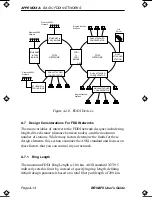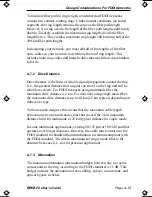
APPENDIX A: BASIC FDDI NETWORKS
Page A-16
BRIM-F6 User’s Guide
The attenuation of the typical multimode fiber optic cable used in FDDI
networks is 2.5 dB/km or 5 dB for the 2 km maximum node separation.
When installing optical bypass switches, each switch could add 2.5 dB to
the attenuation. With an 11 dB budget to work with, and 5 dB expended
on the cable, you can install a maximum of two bypass switches.
A.7.4
Bandwidth
The minimum modal bandwidth of fiber optic cable used in an FDDI
network is 500 Mhz at 1300 nm.
A.7.5
Number of Stations
The number of devices in a single FDDI ring cannot exceed 500. The
amount of propagation delay generated by 1000 physical connections
determines this limit.
With the exception of optical bypass switches, all FDDI devices count as
two connections against the 1000 physical connection budget. You can
easily see how to calculate this number when only dual attached stations
reside on the network (1000 divided by 2 connections for each DAS = 500
nodes). However, to understand how to count connections for other device
types, refer to Figure A-11.
A DAC without attached devices counts as two connections (main ring
connections), the same as a DAS. As you attach each additional SAS or
SAC to the DAC, you must count two connections against the budget, one
for the concentrator port and one for the attached device.
This same logic applies to counting connections for a SAC. The multiple
ports of the concentrator do not count until you attach a device.
BRIM-F Book Page 16 Monday, January 29, 1996 9:26 AM

































